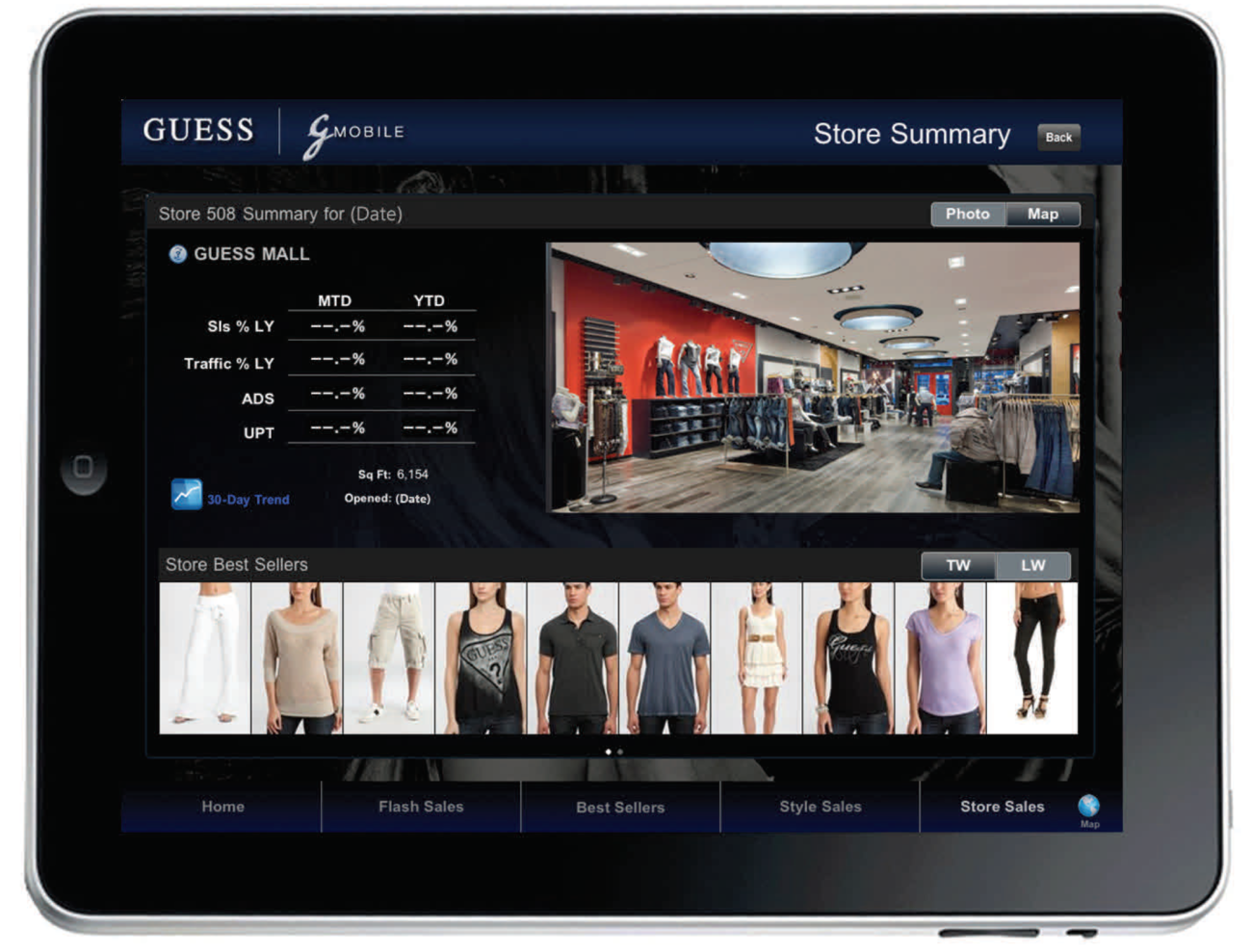This shadowing was important because “the scenarios that we were designing for were so different than anything we had done in the past.” And the approach revealed some surprises. For example, Yen learned that a lot of interaction between a merchant and the app occurred before a store visit, instead of during a visit as predicted. These and other insights were fed into the development process iteratively, enabling the app to support highly emergent workflows.
We wanted the app to have more of an investigative workflow. I can tap and get down to more insight and more detail. And you can go back to your beginning point easily. Think of it as one of those old Choose Your Own Adventure books that we read as kids. Flip to page 73. You open the door on the left. Page 14, you open the door on the right.
Bruce Yen, Director of BI, GUESS?, Inc.
Developing decision-making workflows instead of rolling out reports and dashboards was a shift in thinking from past BI efforts. Ultimately, the content delivered via GMobile equated to more than twelve pre-existing web-based dashboards.
Deeply Understand the Device and the Process: Make BI Easy to Use
As the BI team worked with users, they explored the new device and its ecosystem. Yen explains:
We had never worked with [a tablet] before. We bought devices for everyone on the team, and I told them “download as many apps as you can.” We had impromptu meetings to discuss what we liked to get into the mindset of what makes for a good app.
Bruce Yen, Director of BI, GUESS?, Inc.
Everything was fair game. The team assessed highly regarded media apps and exciting games like Angry Birds and a vegetable chopping game. Through this, they learned how much information to serve up at a time and when. The team noted how apps organized information so that it was easy for people to digest. They learned, for example, that more is actually less: apps should present bite-sized chunks of information that lead to different types of data on demand.
Yen hired a skilled app developer who was able to capture the BI team’s design while emulating cool apps and leveraging device-specific nuances that users would expect, such as swiping and finger gestures. The GUESS? Director of Mexico and Latin America Support explains:
People aren’t afraid to push buttons or try something because they know the tablet is not going to break. They are much more likely to explore. Then, the more you use it, the more you realize new ways to use it.
Director of Mexico and Latin America Support, GUESS?, Inc.
The BI team invested in a leading-edge platform to ensure GMobile interaction would be fast. The app accessed terabytes of data representing thousands of SKUs from 400–500 locations over time, so GUESS? invested in a database appliance to process the data for rapid delivery in the app.
Deliver a “Hip” Experience with Visual Appeal: Make BI Fun
GMobile presents data using charts, graphs, and maps. The team initially underestimated the power of even simple visual approaches.
It was a breakthrough in realizing that visual analytics does not necessarily mean a geospatial tool or a lot of time creating charts and graphs. There was a missing piece of analytics that we could bring just by doing something as simple as adding a picture instead of listing styles so that the users could visually see what’s happening.
Bruce Yen, Director of BI, GUESS?, Inc.
A graphic artist made the app highly intuitive, adding contemporary themes to “spice it up.” The BI team recognized that the device itself also played a role in the initial adoption of GMobile. The users were open to it because it was on a fun, hip device.
At first, I’m not really sure if users wanted [GMobile] simply to get a tablet, but at the end of the day, does it really matter? Once people realized that the app made a real difference in what they wanted to do, they wanted to use it.
Bruce Yen, Director of BI, GUESS?, Inc.
Savvy device users augmented GMobile’s intended capabilities via other apps on the device. For example, they combined PDF readers and notepad apps with GMobile so that all information used to make decisions was integrated on the device. They also began using the tablet’s camera to take photos of store layouts and display strategies.
Use, Usefulness, and Fun = Deep Engagement = Business Value Creation
GMobile is so familiar to people that it’s second nature. My quant in the home office can talk to a creative person in design who can talk with a nineteen-year-old in the stores—and communicate on the same level.
Senior Vice President of Planning and Allocation, GUESS?, Inc.
The result of GMobile is a highly engaged user base whose use of the app translates transactional, informational, and strategic benefits to GUESS?. In a transactional sense, GMobile eliminated paper reporting, allowed two to three FTE-days’ reduction every week in data massaging and manipulation, and decreased best-seller meetings from bi-monthly to monthly because people were “already on the same page” regarding product sales. GMobile improved information flow within and in regards to the company, resulting in better and faster decisions. Data-driven insights increasingly informed strategy, leading to outcomes such as proposed changes in store allocation processes.
GUESS? began its BI journey with “textbook” capabilities—high-quality data and state-of-the-art BI tools that were useful and easy to use for its users. But the company found that this was not enough to maximize value from its BI investments. It was missing a key design element: fun. Once GUESS? embraced a “new look” for BI, its users became deeply engaged and substituted tablets for their five-inch binders.



